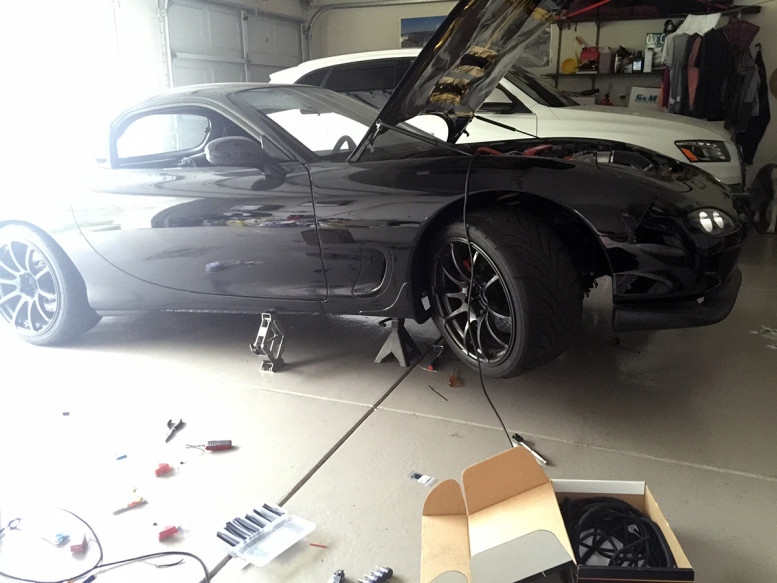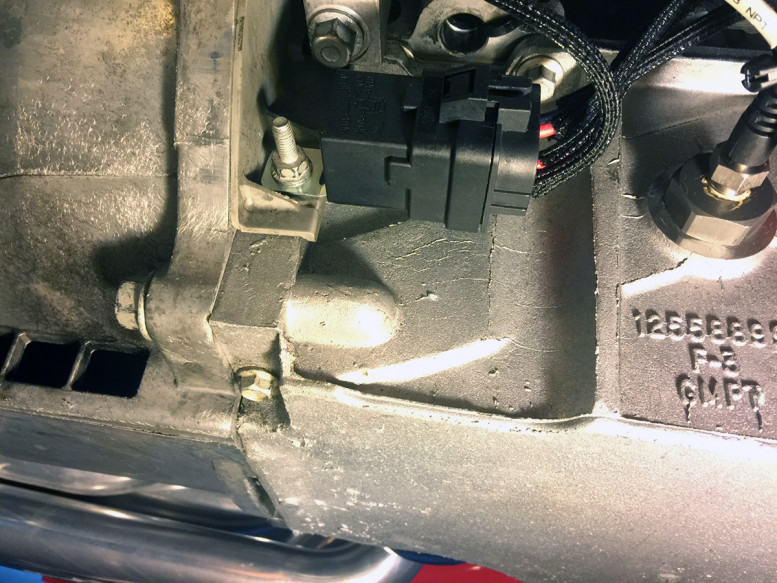In my troubleshooting to resolve the intermittent failure to start issue, I’ve replaced the ignition switch and bypassed Mazda’s security relay. Neither proved to be the solution, but still worth the try and good things to do regardless.
The next logical step is to look deeper at the circuitry and determine the weak link at a more core level – the Mazda ignition wiring. Here’s the theory. The inadequacy of the Mazda ignition wiring creates a voltage drop that occasionally prevents the starter from activating. This is why I only get a click sound when turning the key, and I have to continually retry until it builds up enough to start. I never experienced the clicking when the car was rotary, but the GM starter draws far more amperage than the Mazda starter and I suspect is exceeding the limits of the wiring.
Although this issue has never left me stranded and is somewhat infrequent… it is still annoying. And more importantly, it is a fault and must therefore be corrected. With all the work I’ve invested recently into the RX-7, I can say that I’ve grown rather weary. The easy way would be to raincheck the fix for another day down the road. However, laziness and procrastination are signs of a man who has yet to understand and consider the value of time. In other words, there will be no excuses, the problem gets addressed now.
The solution: rewire the starter to include a “booster” relay. The concept follows the same exact mechanics as the fuel pump rewire where the original power wire is diverted into a signal wire and the relay translates out a more direct source. Interestingly, Pettit sells this in a pre-made kit form, which is essentially a generic relay with an instructions print out.
Instead of spending $50 on their “kit”, I opted for the Do-It-Yourself route and spent $30 on a Waterproof 40A Hella Relay and Pigtail bundle. This relay is heavy duty and features 2 weatherpack seals.
To start the install, I reunited with familiar friends… the jackstands and the soldering iron (the scissor jack is there only as a backup).
There was an ideal location to mount the relay on the passenger side of the engine near the oil pan and the starter. From this spot, I was able to figure out the routing and cut down the leads on the pigtail harness accordingly.
Luckily, I did not have to extend any of the leads and they were long enough to reach all of the necessary places. I crimped on and soldered the ring terminals, used marine-grade heat shrink as per usual, and finished off the leads with more Painless braiding.
The blue wire had to be connected to the old Mazda ignition wire in the car.
Here is how I wired up the starter booster relay.
- Position 87 to Terminal S
- This is typically a spade connector or another type of connector on the starter solenoid. I transferred over the connector to the position 87 lead on the pigtail, as can be seen in the previous picture.
- Position 86 to Ground
- I grounded to one of the starter mounting bolts with a ring terminal.
- Position 30 to Terminal B
- This is the +12V battery source. I connected to the B pole on the starter with a ring terminal.
- Position 85 to Ignition Switch / Old Starting Wire
- This is the Black/Red Mazda ignition wire that was originally connected into Terminal S on the solenoid, and the root of all the issues. Cut this wire and splice, it is now going to be signaling instead of powering.
- Position 87A – Ignore
- I cut off this lead at the base of the pigtail connector and applied RTV to seal up the exposed strands.
With everything hooked up, I reconnected the battery and started up the car. Since it was getting late by the time I finished, I was only able to try starting the car 2 times, but it worked perfectly on both tries. I am going to continue testing and report back. I am hopeful and confident that this is the remedy all along.





I hope this fixes your issue but I honestly don’t think it will.
It’s not common for most cars to only get 10.5v of available voltage at the starter solenoid wire (signal wire). If you ever taken apart a starter or rebuilt one, you will understand that this relay will most likely not fix your issue. The solenoid does not need a lot of amperage or voltage for it to work. All it does is move a plunger and connect larger 12v battery cable to the starter motor via an internal contact.
It sounds like you just have bad contacts in the starter itself.
You could get a replacement starter or change the contacts out yourself.
Good Luck.
Tommy, I agree, a plain bad starter or bad contacts are certainly possible causes, but I didn’t think it pertained to my context exactly and let me explain. The starter on my tranny is very low miles and it just didn’t seem to be the likely culprit. I actually did buy a backup starter just in case and chose not to swap it in yet until I tried this rewire.
The reason why the solenoid clicks is due to insufficient juice / low voltage at the energizing coil, which can certainly point to the Mazda ignition wiring and circuitry as being at fault. Something is causing the solenoid to not get enough voltage. It might be bad contacts, but I think voltage drop through the Mazda wiring is very much feasible.
There is sufficient evidence to support this since the issue appears to be chassis specific, plenty of the factory Rotary guys are having the same problem with the clicking. If so many people with even bone stock FDs are experiencing the same clicking, the numbers made it worthwhile to try. Which is also why Pettit saw the need to sell and market their starter booster relay package. I think in my case, it just became more pronounced after the swap and the GM starter. This is what convinced me the most to be the cause.
I will test this out and see if it holds up and report back. If it doesn’t work out, it is very easy to reverse the relay install and then I will swap in my new backup starter as the next step.
Eric,
Have you tested the available voltage at the starter signal wire to see what it actually is?
If you’re getting less than 9 volts, this relay might help you but I would consider it a “bandaid” fix. It’s obviously not a hack job or anything like that. The relay install is very clean and professional. I’m pretty sure the 20+ year wiring harness isn’t helping your cause.
From the ignition switch to the starter, the starter signal wire probably goes through multiple connectors, and each connector should consume 0.01 – 0.1v. ( This spec only applies to the starter signal wire, normal wiring connectors should consume less than 0.01v ) Even newer vehicles, You can see up to 1.5v voltage drop from the ignition switch all the way to the starter.
I could double check to see how many connectors but I do not have the wiring diagram handy. If you happen to have a connector that is consuming (voltage drop) more than 0.1v, it could be a simple fix as cleaning the connector, repairing poor pin fit, etc..
If this is the case and you have a connector that is consuming more than it should, this bad connector might affect other electrical systems in your vehicle.
I think the reason you’re seeing Pettit selling these booster relay kits because most people will have issues trying to trace down the actual problem. It would be easier just to bypass the fault and install a relay in their eyes.
A multi-meter, a wiring diagram, connector locations, and some time, you could chase down the issue and repair it for good.
Just a thought.
Good points! I’m not going to lie, I didn’t bother to test the starting wire’s voltage with a multimeter because I was partially lazy and also didn’t feel the need for it. I knew it was getting voltage drop so the actual measurement wasn’t particularly important, since whatever value it’s dropping was obviously enough to not be able to trigger the solenoid.
IF this wasn’t the case, I still wanted to give the rewire a shot first since I have replacing the starter as the next and final step.
As you mentioned, even newer vehicles suffer from voltage drop. Mazda’s convoluted setup is really a factor in making things worse for these RX-7s. The ignition wire jumps through like 3 different relays including the security relay and the clutch switch. Voltage is being reduced at these hops, where exactly I am not sure, but it is a common enough of an occurrence to be a widespread problem in RX-7s.
I know the starter relay is technically a workaround, but it’s still a simple enough and effective enough of a workaround that should last.
My other plan was to actually rewire the ignition wire entirely so it bypasses all the in between relays. I could fiddle around and try to find out exactly where the voltage drop is occurring, but I’ve already bypassed the security relay to reduce a failure point, I think it’s a better solution to just rewire and bypass everything all together. I might do this if I end up swapping the starter out. It’s a really easy job to run a new wire from the thick Black/Blue wire, right before the security relay, all the way to the starter. I’m sort of 50/50 about this route because I kind of want to retain the clutch start feature. I know it’s not necessary, but whatever.
i ended up bypassing all the relays and everything. when i changed out my starter and alternator. start stronger every time.
After dealing with starting issues and replacing my battery, starter, and alternator, I found your article to be very helpful. I put together a similar kit with the help of your article, and now my once thought annoying “hot start” issues have disappeared!
Matt-
Glad I could help!
so now my ls3 car has the fail start issue as well.. this is mod still working for you? sonny said he build the relay like you did, hope i dont have to wire the starter to ignition directly like on my silver car
Yep, it works great. Follow what I wrote here and I think you’ll have positive results.